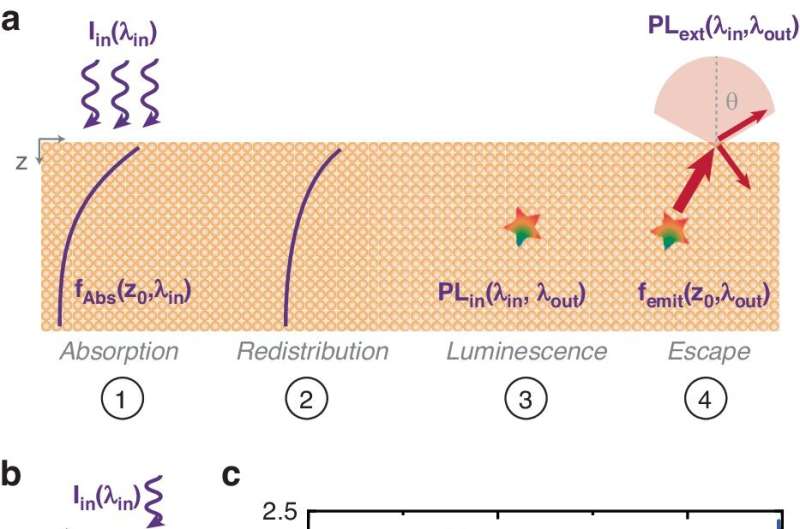a) Schematic diagram of the process that occurs after photon absorption (Equation 1), starting from point 1 to point 4. b) Schematic diagram of the measurement method. The gold sheet is excited from above and below, and the photoluminescence signal is recorded from the same place at the bottom of the two measurements. c) Wavelength dependence of the ratio between the two signals shown in b. d) Angle-resolved luminescence, and predicted angle dependence. Credit: Light: Science and Applications (2024). DOI: 10.1038/s41377-024-01408-2
Researchers at EPFL have developed the first comprehensive model of the quantum mechanical effects behind the photoluminescence of gold films; a discovery that could lead to the development of solar fuels and batteries.
Luminescence, the emission of photons from a substance exposed to light, has been known for centuries to occur in semiconductor materials such as silicon. The nanoscale behavior of electrons as they absorb and then re-emit light can tell researchers a lot about the properties of semiconductors, which is why they are often used as probes to characterize electronic processes, such as those occurring inside solar cells.
In 1969, scientists discovered that all metals emit light to some extent, but the ensuing years eluded a clear understanding of how this occurs. Driven by nanoscale temperature mapping and photochemical applications, renewed interest in this light emission has reignited the debate surrounding its origins. But until now, the answer has been unclear.
Giulia Tagliabue, head of the Faculty’s Laboratory of Nanoscience for Energy Technologies (LNET), said: “We have developed very high-quality metallic gold films, which puts us in a unique position to elucidate this process without being affected by confounding factors from previous experiments.
In a recently published study Light: Science and ApplicationsTagliabue and the LNET team focused a laser beam on an extremely thin (between 13 and 113 nanometers) gold film and then analyzed the resulting faint glow.
The data generated by their precise experiments were so detailed and so unexpected that they collaborated with theorists at the Institute of Science and Technology of Barcelona, the University of Southern Denmark and Rensselaer Polytechnic Institute (USA) to redesign and apply quantum mechanical modeling methods.
The researchers’ integrated approach allowed them to resolve the debate surrounding the type of light emitted by the film (photoluminescence), which is defined by the specific way electrons and their oppositely charged counterparts (holes) behave in response to light. It also allowed them to produce the first complete, fully quantitative model of this phenomenon in gold, which can be applied to any metal.
Unexpected quantum effects
Tagliabue explained that the team studied the photoluminescence process using single-crystal gold films produced by a novel synthesis technique that allows the metal to become increasingly thinner. “We observed certain quantum mechanical effects in films around 40 nanometers, which was unexpected because typically with metals you don’t see such effects until well below 10 nanometers. ,”she says.
These observations provide critical spatial information about exactly where the photoluminescence process occurs in gold, a prerequisite for using the metal as a probe. Another unexpected result of the research was the discovery that gold’s photoluminescence (Stokes) signal can be used to probe the surface temperature of the material itself, which is good news for scientists working at the nanoscale.
“As with many chemical reactions on metal surfaces, there is considerable debate as to why and under what conditions these reactions occur. Temperature is a key parameter, but measuring temperature at the nanoscale is extremely difficult because the thermometer affects your measurements. Therefore, being able to use Using the material itself as a probe to detect the material is a huge advantage,” Tagliabue said.
The gold standard in solar fuel development
The researchers believe their discovery will allow the metal to be used to gain unprecedented detailed understanding of chemical reactions, particularly those involved in energy research. Metals such as gold and copper (the next research target for LNET) can trigger certain key reactions, such as carbon dioxide (CO2) back to carbon-based products like solar fuels, which store solar energy in chemical bonds.
“To combat climate change, we need technology to convert carbon dioxide2 said Alan Bowman, lead author of the study and a postdoc at LNET.
“Using metals is one way to do this, but if we don’t have a good understanding of how these reactions occur on their surfaces, then we can’t optimize them. Luminescence provides a new way to understand what’s happening in these metals.” Case”.
More information:
Alan R. Bowman et al., Quantum mechanical effects of photoluminescence in crystalline gold films, Light: Science and Applications (2024). DOI: 10.1038/s41377-024-01408-2
Provided by EPFL
citation: Comprehensive model reveals quantum mechanical effects behind photoluminescence in thin gold films (2024, April 19), Retrieved April 19, 2024, from https://phys.org/news/2024-04-compressive- unravels-quantum-mechanical-effects.html
This document is protected by copyright. No part may be reproduced without written permission except in the interests of fair dealing for private study or research purposes. Content is for reference only.
#Comprehensive #model #reveals #quantum #mechanical #effects #photoluminescence #gold #films
Image Source : phys.org
